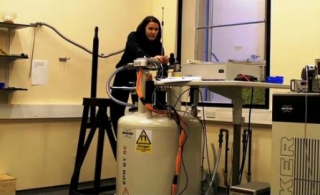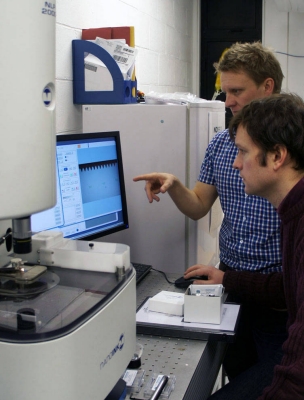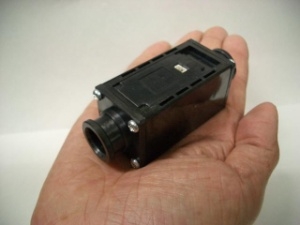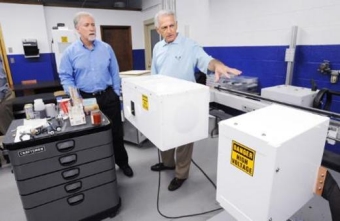January 21, 2011 – JCN Newswire — Professor Kohei Itoh, who is developing quantum computers based on silicon semiconductors at Keio University’s Faculty of Science and Technology, together with Dr. John Morton at Oxford University and others, successfully generated and detected quantum entanglement between electron spin and nuclear spin in phosphorus impurities added to silicon. This accomplishment constitutes a major breakthrough toward the achievement of quantum computers.
"According to Moore’s Law, which serves as the index for semiconductor microfabrication, by 2030, individual atoms in silicon will be used for computing," commented Professor Itoh. "The question of whether that kind of computing is possible was the starting point for my research, and as a way of approaching that question, I began to research computing using atoms in silicon. Now, we’ve performed the first successful experiment on computing using phosphorus atoms in silicon, and been able to create a special state called quantum entanglement. I am glad that this research has led to a world-first result: computing using atoms in silicon, the most important semiconductor."
The results of this research were featured in the British science journal Nature (online edition) on January 19, 2011.
Quantum computers work using entirely different principles from current computers, enabling new characteristics. Quantum superposition and entanglement drive the technology. Classical computers can only use states corresponding to one or other of the binary digits 0 and 1. By contrast, quantum bits, the minimum units for quantum computers, consist of individual quanta, in the form of atoms, electrons, and photons, and can represent 0 and 1 at the same time (superposition state). Another prerequisite for quantum computers is entanglement between at least two quantum bits. In an entangled state, individual quantum bits are entangled in a way that transcends space, so they cannot be separated and treated as 0 or 1.
 This joint research by Keio University and Oxford University has achieved the first successful production and detection of entanglement in silicon. Phosphorus impurities are added to silicon to produce n-type silicon. Phosphorus atoms in silicon at low temperatures, less than 20K, capture an electron and behave like hydrogen atoms. Using this characteristics, the joint research group has produced and detected entanglement between two quantum bits by treating the nuclear spin of a phosphorus atom as one quantum bit and the captured electron’s spin as another quantum bit. The entanglement was produced at once for each of a large number of phosphorus impurities that exist in the sample in the order of 10 to the power of 10. The process of generating entanglement itself is equivalent to quantum computing.
This joint research by Keio University and Oxford University has achieved the first successful production and detection of entanglement in silicon. Phosphorus impurities are added to silicon to produce n-type silicon. Phosphorus atoms in silicon at low temperatures, less than 20K, capture an electron and behave like hydrogen atoms. Using this characteristics, the joint research group has produced and detected entanglement between two quantum bits by treating the nuclear spin of a phosphorus atom as one quantum bit and the captured electron’s spin as another quantum bit. The entanglement was produced at once for each of a large number of phosphorus impurities that exist in the sample in the order of 10 to the power of 10. The process of generating entanglement itself is equivalent to quantum computing.
Previously, coherence of quantum bits in silicon was too short. In ordinary silicon, the quantum information in phosphorus impurities is lost before entanglement is generated and measured. Keio University made coherence sufficiently long by ensuring that all the atoms in the silicon were the isotope 28Si, while a special magnetic resonance (MR) apparatus belonging to Oxford University produced a field of 3.4 Tesla at a temperature below 3K, to obtain high polarization of electron spin and nuclear spin in phosphorus.
In response to the question "What is a state-of-the-art quantum computer?", the usual example cited is a nuclear magnetic resonance (NMR) result with seven quantum bits, where the prime factorization 15 = 3 x 5 was performed successfully [L. Vanersypen, et al., Nature Vol. 414, 883 (2001)]. However, in the NMR research, the same number of calculation steps as in a classical computer was required to make it seem as if seven quantum bits in molecules were aligned, and entanglement was not obtained. By contrast, in this research, by using a low temperature and high magnetic field, and careful arrangements for quantum computing, quantum bits were initialized in a very small number of steps, and entanglement was successfully generated and detected. The entanglement state found in a large number of phosphorus atoms added to silicon constitutes a major breakthrough toward a solid-state quantum computer.
This research was conducted as part of "Quantum spintronics based on donor impurities in isotope-controlled silicon" (research representative in Japan: Prof. Kohei Ito; research representative in the UK: Dr. John Morton), a project in the JST’s "Strategic International Cooperative Program" with the UK’s EPSRC.
Entanglement can be explained with the example of two spatially separated quanta, in London and Tokyo. Suppose that, in both Tokyo and London, a quantum bit is in a superposition state, where its value is both 0 and 1. If the state is determined from before it is measured, but not known until it is measured, the bit is in a classical state, not a quantum state. In a quantum state, before the quantum bit is measured, its state is both 0 and 1, but the instant the state is measured, it becomes a classical state of 0 or 1. Measuring the quantum bit turns it into a classical bit. A case where there is a correlation between the bits, so if the quantum bit in Tokyo is measured and the value 0 is obtained, the quantum bit in London must be 1, and if the Tokyo bit is 1, the London bit must be 0. This is also called entanglement, as the two bits cannot be separated. Even though each of the bits, in Tokyo and London, has a state that is both 0 and 1, the instant the bit in Tokyo is measured and takes the classical state 1, it is determined that the London bit has the value 0. This correlation, which transcends space, exemplifies the mysterious nature of quantum mechanics, which cannot be explained using classical mechanics.
Keio is Japan’s first private institution of higher learning.
Japan Science and Technology Agency (JST) is an integrated organization of science and technology in Japan that establishes an infrastructure for an entire process.
Subscribe to Solid State Technology/Advanced Packaging.
Follow Solid State Technology on Twitter.com via editors Pete Singer, twitter.com/PetesTweetsPW and Debra Vogler, twitter.com/dvogler_PV_semi.



 The D6F-70 MEMS Flow Sensor is capable of measuring up to 70L/min- an improvement of 20L/min from the current model- all with a very high level of accuracy thanks to
The D6F-70 MEMS Flow Sensor is capable of measuring up to 70L/min- an improvement of 20L/min from the current model- all with a very high level of accuracy thanks to  The manuscript describes the process as non-human subjects are exposed to 10 minutes of nonionizing radiofrequency (RF) radiation followed by 36 hours of treatment using targeted gold nanoparticles (AuNP). This revolutionary design shows that the Kanzius RF machine alongside these particular nanoparticles create an effective formula for controlling pancreatic cancer cells. Also read:
The manuscript describes the process as non-human subjects are exposed to 10 minutes of nonionizing radiofrequency (RF) radiation followed by 36 hours of treatment using targeted gold nanoparticles (AuNP). This revolutionary design shows that the Kanzius RF machine alongside these particular nanoparticles create an effective formula for controlling pancreatic cancer cells. Also read: